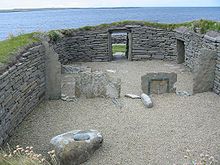
Back Neolitiese Omwenteling Afrikaans الثورة الزراعية Arabic Revolución neolítica AST Neolit inqilabı Azerbaijani Неалітычная рэвалюцыя Byelorussian Нэалітычная рэвалюцыя BE-X-OLD Неолитна революция Bulgarian নব্যপ্রস্তর যুগীয় বিপ্লব Bengali/Bangla Reveulzi neolitik Breton Neolitska revolucija BS

The Neolithic revolution was the first agricultural revolution. It was a gradual change from nomadic hunting and gathering communities to agriculture and settlement.[1] It changed the way of life of the communities which made the change. It occurred in different prehistoric human societies at different times. Many societies changed 10–7 thousand years ago.
The term refers to the general time period over which these developments took place. It also applies to the developments in social organization and technology. These included the adoption of early agriculture techniques, crop cultivation, and the domestication of animals.[2]
The Neolithic revolution led to people living in permanent or semi-permanent settlements. Because of this fewer people led a nomadic lifestyle. To be able to know who the crops grown belonged to, the concept of land ownership was developed. The natural environment was changed, population sizes grew, and people ate more vegetable and cereal foods in their diet. Hierarchies developed in society. Grain was stored, and could be traded. Surplus production from good crop yields helped societies survive bad years.
- ↑ The term neolithic revolution was first coined in the 1920s by Vere Gordon Childe to describe the first in a series of agricultural revolutions to have occurred in Middle Eastern history. This period is described as a "revolution" to show its importance, and the great significance and degree of change brought about to the communities in which these practices were gradually adopted and refined.
- ↑ Heather Pringle. "The slow birth of agriculture". Archived from the original on 2011-08-20. Retrieved 2008-04-12.
© MMXXIII Rich X Search. We shall prevail. All rights reserved. Rich X Search